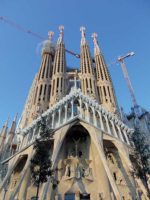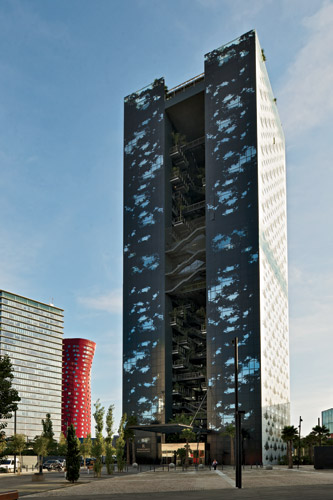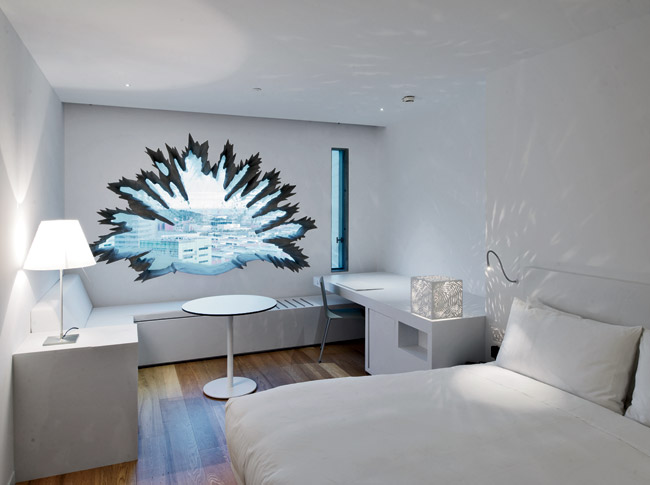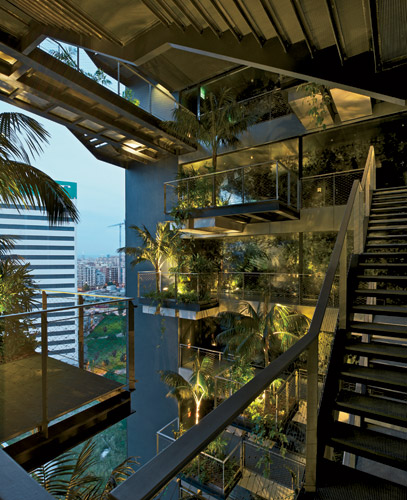Renaissance Barcelona Fira Hotel
Urban Oasis: Ateliers Jean Nouvel creates a lively, playful hotel tower amid the city's dismal fringes.












Architects & Firms
Barcelona
For the Renaissance Barcelona Fira Hotel, sited near a convention center on the highway to the city's airport, Jean Nouvel took on the challenge of making meaningful architecture out of what Rem Koolhaas famously defined as “junkspace“—the anonymous, generic sprawl that rings cities everywhere. Nouvel's response was to use the concept of an oasis or refuge from the uninspiring surroundings as a design theme in both literal and figurative terms.
The literal oasis is a central open-air garden that runs vertically through the hotel's 26 floors, filling every level with palm trees and other vegetation. This vertiginous, north-facing void, animated by zigzagging fire stairs, rises between two solid volumes containing guest rooms. These are accessed from single-loaded open galleries that overlook the garden and its spectacular views to the city. As project leader Damien Renchon points out, “It's really a vertical motel.” The central void is interrupted by a restaurant on the 14th floor, as well as penthouse suites and a rooftop bar and swimming pool, which are all surrounded by glass-enclosed terraces housing more greenery.
The apparent whim of the central garden solved a serious design problem, as the large square footprint required by the site's urban plan was impractical for laying out hotel rooms. Cutting out the core also resulted in a building with “more elegant proportions,” says Renchon; the architects persuaded local authorities not to count the central space as part of the permissible built area, allowing for a taller, and proportionally slimmer, volume.
On the figurative side, Nouvel carries the oasis concept into a branding theme for the facades. Inside every guest room, he cuts a window out of the structural precast-concrete wall in the shape of the jagged crown of a palm tree. Outside, these openings are visible behind a continuous curtain wall of milk-white glass, silkscreened with palms at different scales, that blurs the reading of floor lines. Rooms on the northern facade, with negligible solar load, look out through a contrasting black-glass curtain wall, silkscreened with patterns of leafy shade. The other facades fade into full transparency at the restaurant floor as well as at the building's top. The result, both inside and out, is unexpected, campy, and fun.
Throughout the building, Nouvel expands on the palm-tree motif to shape perceptions of light, shade, and space. He silkscreens reflective and transparent surfaces with patterns of palm fronds, including the glass walls of guest-room baths, the reflective steel walls of the open corridors, and the windows in the lobby, where images of leafy shade mix with glimpses of the real thing outside. In one endearing detail for the architect's otherwise discreetly elegant furnishings (with selections from his own line), each guest room has a kinetic light fixture that projects a changing play of palm-frond patterns over the walls, a bedtime version of a disco ball.
The project is not Nouvel's first to try a lively strategy for a dismal site. In Madrid's Puerta Ámerica Hotel he oversaw the work of 15 star architects, each designing a different floor (Record, September 2005, page 96). At the Fira, Nouvel repeats some of the features he introduced there, including the rooftop bar and pool deck, and suites with large interior sliding glass panels for staging different spatial configurations. And, like his Agbar Tower in Barcelona, the new hotel has a structural concrete shell (for thermal insulation) that is sheathed in glass, although here he handles the openings with greater aplomb.
With its green thumb and pop motifs, Nouvel's design demonstrates how mainstream architecture has caught up with some of the more iconoclastic green architects of the recent past, including James Wines, Emilio Ambasz, and Ken Yeang. But he brings to the oasis theme a playful sophistication and spatial intricacy that are entirely his own.
Size: 280,000 square feet
Cost: $72 million
Completion date: September 2012
Architect:
Jean Nouvel - Ateliers Jean Nouvel, Paris, France
RIBAS & RIBAS Arquitectos, Barcelone, Espagne
PeopleOwner: Hoteles Catalonia Architect: Personnel in architect's firm who should receive special credit: PROJECT LEADER: Damien Renchon, Jos' Miguel Pomares ARCHITECTS Architect of record: Engineer(s): Building services [HVAC]: Ram'n Roca Consultant(s): Lighting: Lumi'res Studio (Odile Soudant) Acoustical: Joan Altavella facade: Biosca & Botey |
ProductsExterior cladding Metal/glass curtain wall: Wicona (Metal), Ari'o (glass) Precast concrete: Escofet Curtain wall: Wicona Windows Glazing Interior finishes Suspension grid: Paralum (ceiling lobby) by Troll (Jean Nouvel design) Demountable partitions: Dorma Solid surfacing: Abalit with Samsung, Hi-macs materials Furnishings Chairs(restaurant):Alis (Jean Nouvel design) Lighting Exterior: We-ef Dimming System or other lighting controls: Daly Conveyance Other unique products that contribute to sustainability: |









